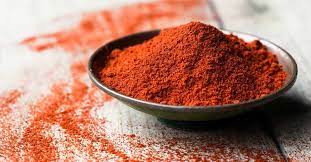It’s safe to say that paprika is one of the top 5 spices used in America, along with cumin, cinnamon, black pepper and garlic. If you hadn’t looked very deep into it, you may not have realized the importance of paprika in seasoning all types of food – I didn’t until I started working for a spice company. Paprika is widely known for being sprinkled on top of deviled eggs, but you might not have realized that it is one of the top ingredients in spice blends (mostly for color). Whether by itself, or in a spice blend, paprika is getting much more attention recently, and rightly so.
Paprika is a powder made from grinding a variety of dry pods of various Capsicum annuum chiles. Just like tea, chiles can be very different depending on where they were grown. This means that there are a few different varieties of paprika that range in flavor and heat profiles. Depending on the variety of chile and how it’s processed, the color may range from brown to a bright red and the heat from mild to mildly spicy. Some paprika has no heat, but is still flavorful and sweet and on the other end of the spectrum is paprika that is bursting with flavor and a fairly decent amount of heat.
Choosing the Best Paprika for You
As you know now, there are different paprikas that have different flavor profiles and are used in different ways. Let’s look at the different types of paprika so you can create the best flavor combinations possible.
Hungarian Paprika
Hungarian Paprika is the paramount spice used in Hungarian cooking. In Turkey and Hungary it is often placed on the table and used in the same way that we would use pepper in the United States. Hungarian paprika takes seven months from seed planting to harvesting. It tends to be a bit sweeter than other paprikas due to the country’s cool growing season, which retains sugar in the spice.
Hungarian paprika is typically used for flavor and color. The deep red color adds a rich hue to anything it is added to. Hungarian Paprika is often found in casseroles, white cheeses, chili, egg dishes, marinades, rubs, salads, stews and it also goes well with most vegetables, pork and rice dishes.
Domestic Paprika
Domestic paprika has a slightly sweet and an almost fresh, green quality to it. It is perfect when you want to add some red color and a bit of pungent sweetness to any recipe. Domestic Paprika is delicious when added to cheeses, chicken, duck, egg dishes, hors d’ouvres, rice, salads, smoked foods, vegetables and cottage cheese. We also like to use it in salad dressings, where it not only adds some color but it also works as an emulsifier (combining the oil and vinegar).
Smoked Sweet Paprika
Smoked Sweet Paprika is called by a few other names around the world including pimenton, smoked pimenton, sweet paprika, Spanish paprika, or any variation of these names. You can always recognize this spicy paprika by its full range of sweetness combined with lingering smoky notes frequently found only in hotter chiles like the Chipotle and Pasilla de Oaxaca.
Smoked sweet paprika is made by drying freshly harvested ripe red pimento peppers in low-lying, adobe smoke houses that are slowly heated by smoking grills fired with slow-burning oak planks. After smoking, the paprika is milled by electrically powered stone wheels which must turn very slowly, as heat from friction adversely affects the signature color and flavor.
Smoked Paprika Hot
Smoked Paprika Hot (also called picante) is a Spanish Paprika that has been smoked the traditional way – without the short cuts often found in the larger commercial paprika productions. The end result is a deep, dark earthy red color with a touch of mild heat (about 500 – 1,000 on the Scoville Heat Unit Scale).
Smoked Paprika adds an authentic flavor to Spanish style paellas. It’s also a key ingredient in Spanish chorizo sausage and lomo pork loin. In American cuisine Smoked Paprika has recently become a secret ingredient used to season pork barbecues, chicken kebabs, and hearty beef and lamb stews.
How to Cook with Paprika
Now that you know the subtle nuances of different types of paprika you are ready to experiment a little. Paprika can be used by itself or with other spices to season your food. If you are using paprika by itself for the first time we have a few guidelines to help you.
- Always remember the ½ rule. When using a new spice always start with ½ the amount that you think you will need. You can always add more, but you can never take away. Also, paprika is full of flavor and color so a little bit goes a long way.
- When cooking with Paprika make sure there is always a liquid component, otherwise your Paprika will burn almost instantly, stick to the pan and create a bitter taste.
- Add Paprika in the middle to the end of cooking, unless the recipe specifies otherwise. Because Paprika is ground, you do not want it to lose flavor before it makes it to your plate. This also keeps the Paprika from being exposed to high temperatures for too long which can result in burning.

